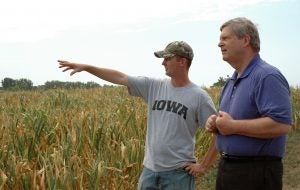Ag producers around the country watched the 2020 U.S. presidential elections with mixed emotions and little clarity as to which candidate was really theirs. After a most tumultuous year for all things related to COVID-19, the ag industry, like all others, was more than perplexed at what the future had in store. That said, with the results now firmly in and U.S. President Joe Biden in the White House, farmers and their related business partners are already feeling more confident that they at least understand the direction this administration will be taking over the next four years.
With Biden’s decision to return former President Barack Obama administration’s Tom Vilsack to the position of Secretary of Agriculture, it seems clear that many of that administration’s larger policy initiatives and overall goals will return. For the ag industry, that brings a mixed bag of cheers and jeers.
But the good news is, familiarity yields some degree of predictability.
In the boil-down, Vilsack is seen as a relatively strong ally of the larger commercial ag industry, which has many progressive Democrats a bit a’boil as they’d hoped for harder-line climate change, Supplemental Nutrition Assistance Program, and race-related issues. That said, Vilsack has received high praise from the groups ranging from the National Association of State Departments of Agriculture, the Edge Dairy Farmer Cooperative, the National Corn Growers Association, the National Association of Conservation Districts, and the American Farmland Trust.
Here we take a deeper look at some of the specifics:

Secretary of Agriculture Tom Vilsack
Most recently the president and CEO of the U.S. Dairy Export Council, Vilsack has served in that role since 2017 following his years as Secretary of Agriculture under Obama, where he earned the distinction of being that administration’s longest serving Cabinet member. While the Biden Administration will be the overall driver in terms of policy, Vilsack’s role is vital specifically to agriculture and to how the industry will be shaped in the coming years.
His nomination, which was on the Senate’s fast track, was perhaps considered a “safe” choice by many considering the division over the other leading candidates: Heidi Heitkamp, a former senator from North Dakota, and Marcia Fudge, a congresswoman from Ohio.
While at the USDEC, Vilsack’s role was to serve as the organization’s primary spokesperson and provide strategic leadership while promoting their research, regulatory, and trade policy initiatives. A native of Pittsburgh, Vilsack was born into an orphanage, later adopted, and ultimately graduated from Hamilton College and Albany Law School in New York. With his wife, Christie, he moved to her hometown of Mount Pleasant, Iowa, to practice law, and ultimately serve two terms as governor of that state.
In addition to policy matters, members of the Biden administration have noted that one of Vilsack’s roles will be to serve as an emissary to the rural states which have tended away from Democratic candidates over the years, in favor of Republicans.
“It isn’t an overnight problem to be solved. It’s a long-term investment in understanding, appreciating and respecting rural America,” stated spokeswoman Anne McMillan on his behalf.

President Biden’s Ag Initiatives
In terms of agriculture policy, Biden’s platform proposals remained remarkably consistent throughout the din and furor of the 2020 primary and general election. With his pick of Vilsack and statements made in the earliest weeks of selection, it seems likely that those goals will remain in place.
- Immigration: Considered an ag issue due to the high numbers of farm workers who come to America for work, the Biden administration is pledging sweeping moves to undo the rules laid down by his predecessor, President Donald Trump. The package would provide a path to legal citizenship for as many as 11 million people presently undocumented or in the U.S. illegally. Agricultural labor supply has long been a cause championed by groups such as the American Farm Bureau Federation. It’s good to keep in mind that the Biden administration is quite keen on all things green as well as social justice, so moves involving immigration passes will most certainly hinge in that direction.
- Infrastructure: The Biden administration is also seeking a multi-trillion-dollar infrastructure plan focused on green energy, rural Wi-Fi, bridges, roads, water systems, and the electrical grid. As infrastructure and transportation are crucial elements for ag producers, many see this as a positive, although concerns about new regulations are ever-present. No doubt, the Biden team is seeing most issues in a shade of Green. For instance, the USDA maintains a multibillion-dollar fund called the Commodity Credit Corp, long used as a funding vehicle for producer payments. Biden’s team is actively calling for that to be converted into a “carbon bank,” which would help produces transition to greener practices.
- Rural communities: Clearly both a political and economic goal of the new administration is to win hearts and minds in rural America, which has in recent years trended away from the Democrats. Although some minorities within the Democratic Party claimed disappointment in the pick of Vilsack over a minority, the administration’s stated commitment to increasing opportunities and funding for minority producers remains among the highest of its goals. In addition to greener practices, the administration has pledged to help support smaller and mid-sized operations which have felt ignored in the past.
- Crop subsidies: Throughout the campaign, Biden has emphasized his intent to emphasize conservation payments and use of agriculture as a way to address climate change through practices such as carbon sequestration. Biden has called for the ag industry aiming for a zero emissions over time, which could include support for biofuels and ethanol. With the COVID-19 quarantines and shut-downs hopefully nearing an end, the question of how much subsidization will occur going forward is a bit foggy yet. Producers under the Trump administration received record sums in terms of support, but to a large degree those sums went part-and-parcel with trade battles and COVID-19. Again, with the Biden administration, crop subsidies are going to be seen as tools in their efforts to affect social change on the behalf of smaller operation, minority farmers, and the climate change issues.
- Trade: From the start, foreign trade talks have dominated the political discussions for not just agricultural industries, but nearly all. With the U.S. still holding significant tariffs on various Chinese goods, farmers who deal with that nation and others have been both shaken and stirred. The Biden administration has maintained that it will continue working for better trade deals with China, but promises to take a less combative approach then their predecessor, forgoing the unilateral approach to a multi-lateral one with other allies. Biden is also expected to return to the Trans-Pacific Partnership.
Growing Forward
One consistent message throughout the 2020 election was Biden’s intent to help smaller and mid-size farms as opposed to the larger operations. How exactly that comes into play remains to be seen, but the team commitment to social justice issues across all boards includes those smaller operations as well. Tax policy will also undoubtedly be driven toward shifting a greater burden onto higher earners and companies with higher revenues, which in turn would be explained as a benefit to smaller farms and their owners.
In boiling down the message from all different topics one sees that while basic programs will remain the same in terms of structure, smaller and greener will be the buzz words for the foreseeable future. Producers and enthusiasts throughout the field of agriculture can take note that with familiar faces come familiar results. Fans of the Obama-era USDA will most likely take comfort in that, while those unhappy with that team’s tax and regulation strategy will not.
Brian Boyce is an award-winning writer living on a farm in west-central Indiana. You can see more of his work at www.boycegroupinc.com.



